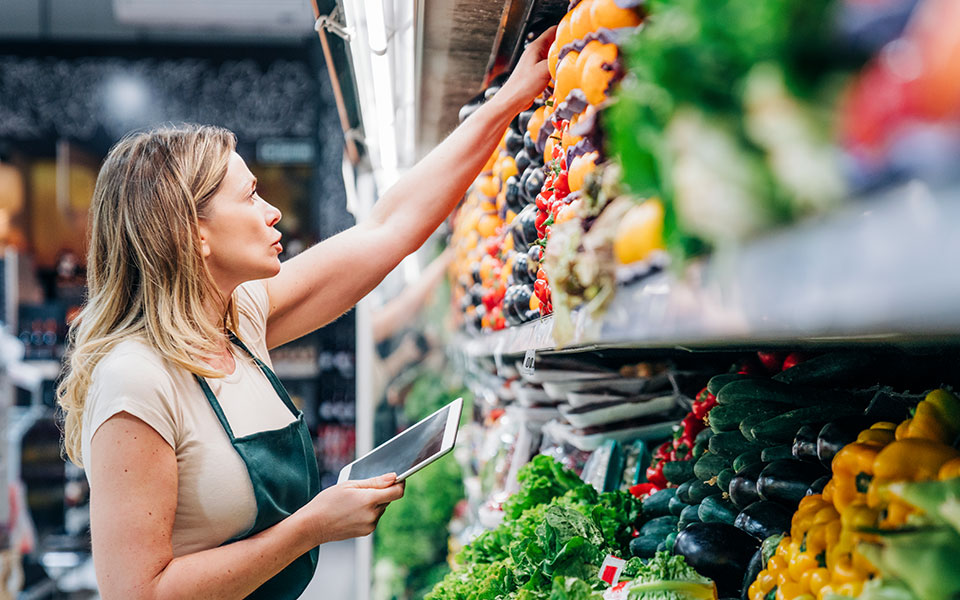*On June 1, 2023 Emerson’s Climate Technologies business became a new standalone company – Copeland. Though our name has changed, we are building on more than a century of HVACR innovation and industry leadership, and Copeland continues to offer the same products, industry stewardship, and learning opportunities you’ve grown to trust. Information found on this webpage posted before June 1, 2023 may contain our old name or branding, but you can be at ease knowing it was created with the knowledge and expertise of Copeland.
As essential businesses, food retailers were among the few sectors that had remained open during the early stages of the coronavirus pandemic. Staying open meant they would have to adapt quickly to new operating protocols, which often included one-way aisles, plexiglass shields at registers and enhanced cleaning procedures. Grocers were also inundated with high volumes of click-and-collect orders, which tested their e-fulfillment capabilities and presented additional challenges. I recently contributed to an ACHR News article discussing the shifting grocery landscape and its potential impacts on store and refrigeration system designs.

Attempts to provide “contactless” shopping experiences were among the first areas of focus, as store layouts were modified to limit the need to touch physical items and surfaces. While these were originally intended as stop-gap strategies, some of these short-term measures have already become more permanent elements of in-store designs. In fact, new store builds and remodels will likely feature layouts and case placements that are designed to adhere to as many safeguards as possible and provide much-needed merchandizing flexibility.
Of course, this shift will also affect the type of refrigeration architectures grocers select to address these emerging challenges. Flexibility in refrigeration translates first into the ability to meet typical capacities, but also provides the freedom to scale up or down to meet fluctuations in demand — such as staging additional self-contained cases or enabling variable-capacity modulation in walk-in units that support click-and-collect.
Shoring up stores for click-and-collect
While demand for click-and-collect fulfillment surged significantly during the initial onset of the pandemic, months later it shows little to no signs of letting up. In fact, recent reports indicate a 23 percent growth in click-and-collect adoption from June to July. Many experts believe this change in consumer behavior will represent a more permanent change in buying habits — although the degree to which it becomes a preferred shopping method remains to be seen.
Fortunately for most major retailers, click-and-collect capabilities have been in place for several years. But that doesn’t mean they were necessarily prepared for pandemic-level order volumes. In terms of fulfillment and execution, this emerging business model presents a variety of cold storage, picking and associated labor requirements.
As retailers respond to the increased amount of online shopping, they will need to account for fluctuations in consumer demand and the impacts on refrigeration equipment loads. Refrigeration design strategies with variable-capacity modulating compressors — such as the Copeland™ digital outdoor refrigeration unit, X-Line Series and Copeland scroll compressors — will help retailers balance click-and-collect refrigeration loads more effectively.
Another effective strategy is to implement “dark stores,” which are dedicated online fulfillment centers. Retailers who operate dark stores essentially take load fluctuations from click-and-collect activities out of the equation, which may make it easier to balance refrigeration loads. Whichever method is preferred, retailers will ultimately approach click-and-collect services differently, depending on their local demographics and store design strategies.

8 proven strategies for rigorous cold chain management
Preparing for the approval and safe use of A2Ls in commercial refrigeration applications...
Protection for high-value shipments just got even better
We’re excited to announce the release of Copeland’s newest real-time tracker, the GO Real-Time...

Three proven strategies to prevent cargo theft
The over-the-road (OTR) transport industry is experiencing a surge in cargo thefts. As thieves...
